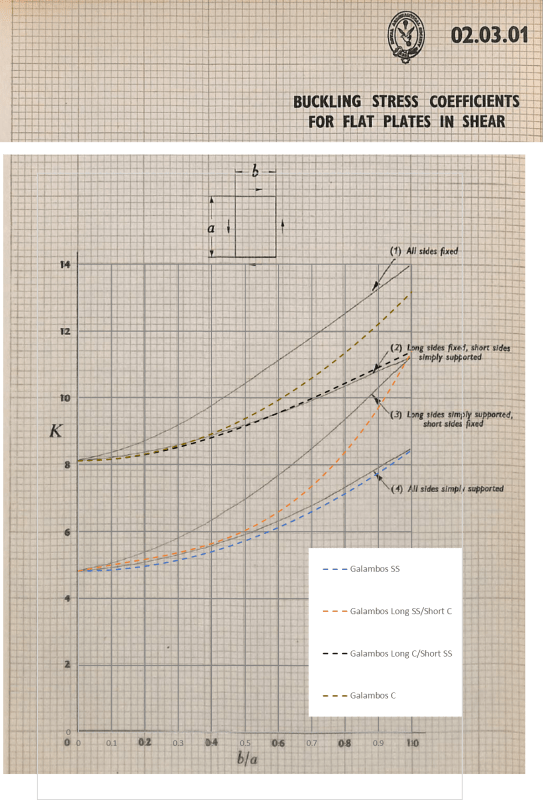I'm on a bit of a scavenger hunt. I've got a chart of shear buckling coefficients vs aspect ratio for unstiffened rectangular flat panels with different boundary conditions (all sides simply supported, all sides clamped, long sides SS/short sides C, and long C/short SS). One of my colleagues said he tried using some curve fits published in another reference, and noticed a significant difference for the long SS/short C case.
The chart is dated from the 1950s, and references NACA TNs that individually address the all SS and all C cases, Timoshenko's Theory of Elasticity that addresses both of those and long C/short SS, and also the Royal Aeronautics Society Data Sheets for Stressed Skin Structures, which I assume must cover the long SS/short C case, because none of the others do.
All the references I can actually find for long SS/short C case agree pretty well with each other, and disagree with my chart. Some quick FEMs to spot check things also line up with those references. So I'm pretty confident that my chart is in error, but I'd like to find the RAeS document to see if maybe I'm interpreting a boundary condition incorrectly or something.
I believe the number of the Data Sheet I'm looking for is 02.03.01. The RAeS Data Sheets were replaced by ESDU, and ESDU 71005, Buckling of Flat Plates in Shear, noted that it supersedes 02.03.01. (And ESDU 71005 lines up with all the other references, and doesn't match my chart.)
Hoping one of you might have a copy. Appreciate any help you can provide!
The chart is dated from the 1950s, and references NACA TNs that individually address the all SS and all C cases, Timoshenko's Theory of Elasticity that addresses both of those and long C/short SS, and also the Royal Aeronautics Society Data Sheets for Stressed Skin Structures, which I assume must cover the long SS/short C case, because none of the others do.
All the references I can actually find for long SS/short C case agree pretty well with each other, and disagree with my chart. Some quick FEMs to spot check things also line up with those references. So I'm pretty confident that my chart is in error, but I'd like to find the RAeS document to see if maybe I'm interpreting a boundary condition incorrectly or something.
I believe the number of the Data Sheet I'm looking for is 02.03.01. The RAeS Data Sheets were replaced by ESDU, and ESDU 71005, Buckling of Flat Plates in Shear, noted that it supersedes 02.03.01. (And ESDU 71005 lines up with all the other references, and doesn't match my chart.)
Hoping one of you might have a copy. Appreciate any help you can provide!


